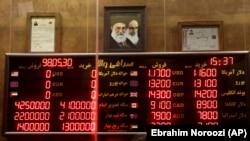Immediately after the United States announced the return of international sanctions on Iran on Sunday, the dollar exchange rate set a new record high with a 2.5 percent increase to the rate of 273,000 rials per dollar.
The U.S. dollar exchange rate was 160,000 rials at the beginning of the current Iranian calendar year starting March 20, but previously reached 250,000 rials in late July.
In the last week leading up to July, the Central Bank of Iran (CBI) injected about one billion dollars of foreign exchange into the local market, and the price of the dollar fell to 210,000 rials. In time, the exchange rate started to fluctuate again.
The price of "Emami" gold coin also increased by 4 percent to 132,640,000 rials (roughly $3,000) on Sunday, setting another record. The price of other types of coins also increased significantly.
CBI Governor Abdol Nasser Hemmati announced on September 16 that while heavily supplying the NIMA (forex) market with hard currencies, he had authorized petrochemicals, steels, and minerals firms to transact their export currency directly at the licensed exchange bureaus outside the CBI.
Analysts, however, believe that the CBI is not capable to "heavily" supply the market with the needed hard currencies. The daily increase in the price of various foreign currencies in Iran supports the analysts' belief.
Earlier this year, the International Monetary Fund (IMF) released a forecast predicting that Iran's foreign exchange reserves would fall by about $19 billion in 2020 to $85 billion and to $69 billion next year.
A significant part of Iran's foreign exchange reserves is blocked abroad, and Iran can only use them to import authorized goods. This year, for the first time, Iran's foreign trade balance has turned negative, and there appears to be no hope of improving the country's foreign exchange reserves.
The IMF also predicted that Iran's total oil and related services exports will reach $46 billion in 2020, while its imports will exceed $64 billion. Before the U.S. sanctions, Iran's exports numbers topped $100 billion.
In the meantime, the Tehran Stock Exchange (TSE) index also fell by more than 47,000 units on Sunday. The TSE index at the beginning of this solar year was about 500,000 units.
Still, while the country is facing a decline in GDP for the third consecutive year and struggling with an economic crisis, the stock index strangely exceeded two million units in mid-August.
Many experts warned of government manipulation of the TSE and the existence of bubbles in the market.
Since August 10, the TSE index has started falling sharply, reaching 1,650,000 units on Sunday.





